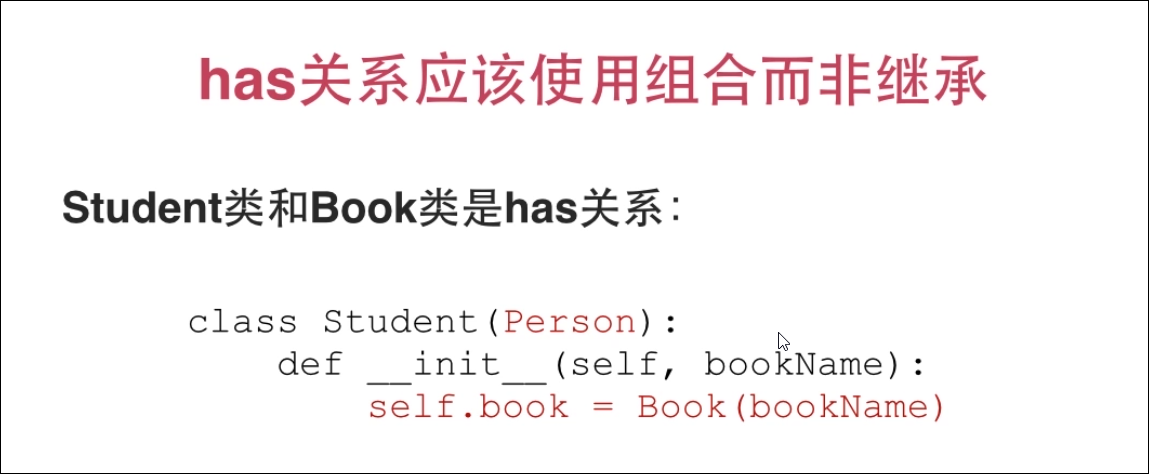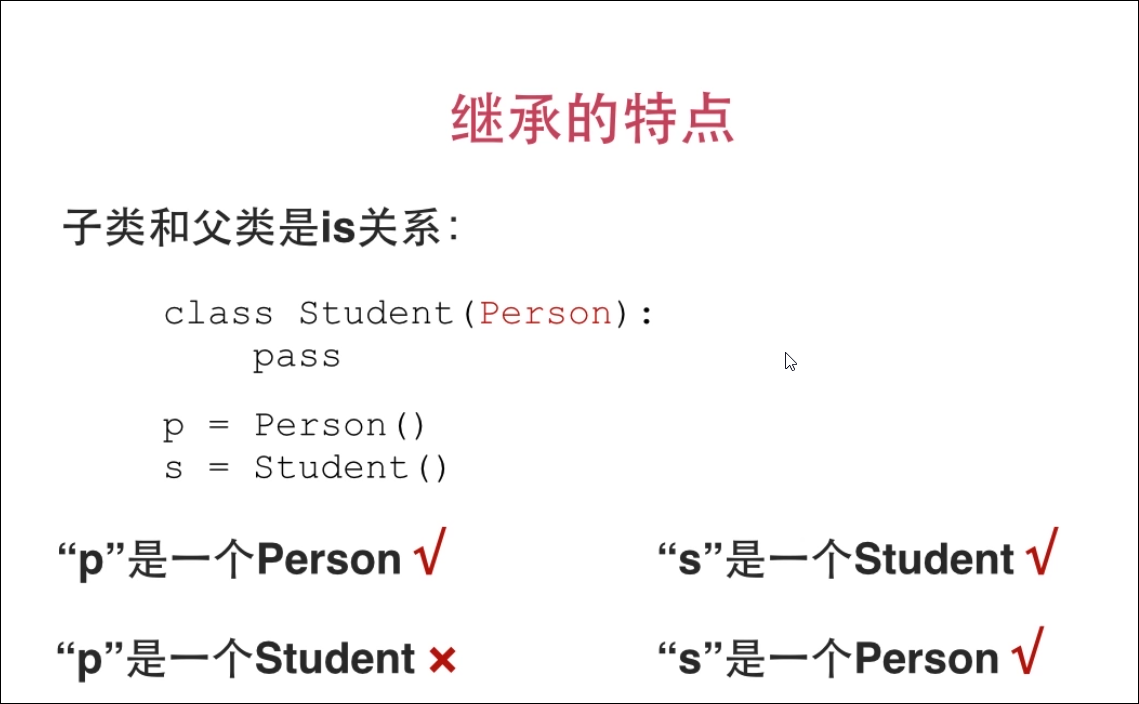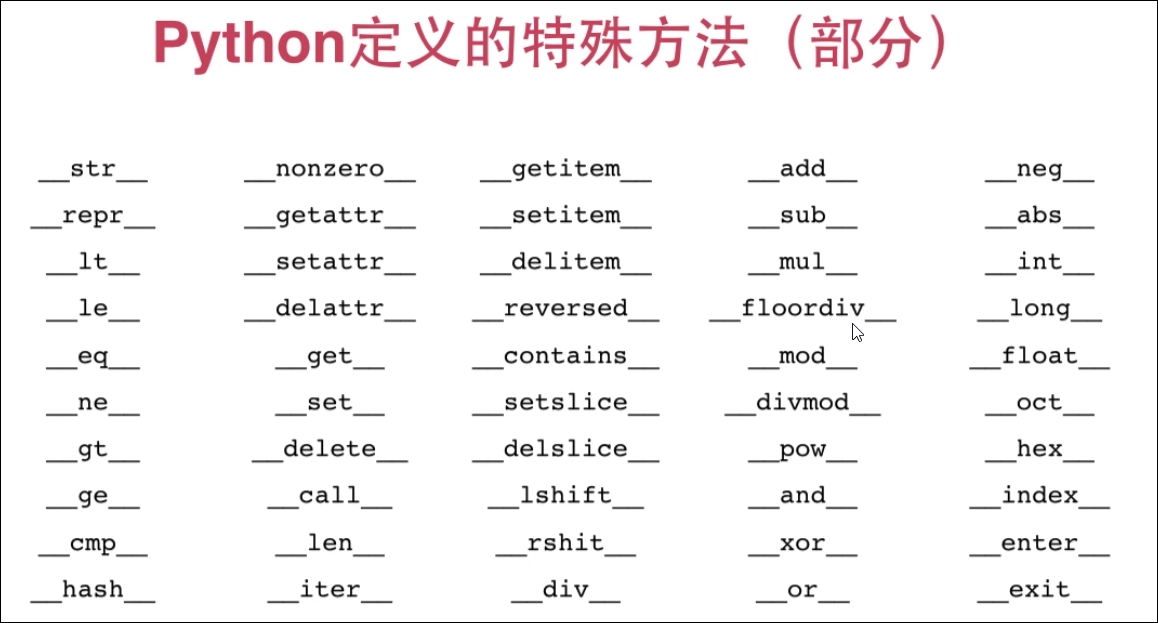1. python json.dumps() json.dump()的区别
注意cat ,是直接输出文件的内容
load和loads都是实现“反序列化”,区别在于(以Python为例):
-
loads针对内存对象,即将Python内置数据序列化为字串
如使用json.dumps序列化的对象d_json=json.dumps({'a':1, 'b':2}),在这里d_json是一个字串'{"b": 2, "a": 1}'
d=json.loads(d_json) #{ b": 2, "a": 1},使用load重新反序列化为dict
-
load针对文件句柄
如本地有一个json文件a.json则可以d=json.load(open('a.json'))
相应的,dump就是将内置类型序列化为json对象后写入文件
2. sorted和sort
sorted(iterable, cmp=None, key=None, reverse=False)
3. 请定义Person类的__init__方法,除了接受 name、gender 和 birth 外,还可接受任意关键字参数,并把他们都作为属性赋值给实例。
class Person(object): def __init__(self,name,gender,birth,**kw): self.name = name self.gender = gender self.birth = birth for key,value in kw.items(): setattr(self,key,value) xiaoming = Person('Xiao Ming', 'Male', '1990-1-1', job='Student') print xiaoming.name print xiaoming.job
34 请给 Person 类添加一个类属性 count,每创建一个实例,count 属性就加 1,这样就可以统计出一共创建了多少个 Person 的实例。
class Person(object): count = 0 def __init__(self,name): self.name = name Person.count += 1 p1 = Person('Bob') print Person.count p2 = Person('Alice') print Person.count p3 = Person('Tim') print Person.count
5. 类的私有变量不可以直接获取,但可以用方法实例或者类私有方法获取
# 通过实例的方法获取 class Person(object): __count = 0 def __init__(self,name): self.name = name Person.__count += 1 def get_count(self): return Person.__count p1 = Person('Alice') p2 = Person('Tom') print p1.get_count() # => 2 # 通过类私有方法获取 class Person(object): __count = 0 def __init__(self,name): self.name = name Person.__count += 1 @classmethod def get_count(self): return self.__count p1 = Person('Alice') p2 = Person('Tom') print Person.get_count() # => 2
6. 类的继承和组合
每个类的定义都需要继承,没有的话,就从object继承
6.1 组合:has关系

6.2 继承:is关系

示例:
class Person(object): def __init__(self, name, gender): self.name = name self.gender = gender class Teacher(Person): def __init__(self, name, gender, course): super(Teacher,self).__init__(name,gender) #或者Person.__init__(self,name,gender) self.course = course
7. python中多态
类具有继承关系,并且子类类型可以向上转型看做父类类型,如果我们从 Person 派生出 Student和Teacher ,并都写了一个 whoAmI() 方法:
class Person(object): def __init__(self, name, gender): self.name = name self.gender = gender def whoAmI(self): return 'I am a Person, my name is %s' % self.name class Student(Person): def __init__(self, name, gender, score): super(Student, self).__init__(name, gender) self.score = score def whoAmI(self): return 'I am a Student, my name is %s' % self.name class Teacher(Person): def __init__(self, name, gender, course): super(Teacher, self).__init__(name, gender) self.course = course def whoAmI(self): return 'I am a Teacher, my name is %s' % self.name
在一个函数中,如果我们接收一个变量 x,则无论该 x 是 Person、Student还是 Teacher,都可以正确打印出结果:
def who_am_i(x): print x.whoAmI() p = Person('Tim', 'Male') s = Student('Bob', 'Male', 88) t = Teacher('Alice', 'Female', 'English') who_am_i(p) who_am_i(s) who_am_i(t) 运行结果: I am a Person, my name is Tim I am a Student, my name is Bob I am a Teacher, my name is Alice
这种行为称为多态。也就是说,方法调用将作用在 x 的实际类型上。s 是Student类型,它实际上拥有自己的 whoAmI()方法以及从 Person继承的 whoAmI方法,但调用 s.whoAmI()总是先查找它自身的定义,如果没有定义,则顺着继承链向上查找,直到在某个父类中找到为止。
由于Python是动态语言,所以,传递给函数 who_am_i(x)的参数 x 不一定是 Person 或 Person 的子类型。任何数据类型的实例都可以,只要它有一个whoAmI()的方法即可:
class Book(object): def whoAmI(self): return 'I am a book'
这是动态语言和静态语言(例如Java)最大的差别之一。动态语言调用实例方法,不检查类型,只要方法存在,参数正确,就可以调用。
任务
Python提供了open()函数来打开一个磁盘文件,并返回 File 对象。File对象有一个read()方法可以读取文件内容:
例如,从文件读取内容并解析为JSON结果:
import json f = open('/path/to/file.json', 'r') print json.load(f)
由于Python的动态特性,json.load()并不一定要从一个File对象读取内容。任何对象,只要有read()方法,就称为File-like Object,都可以传给json.load()。
请尝试编写一个File-like Object,把一个字符串 r'["Tim", "Bob", "Alice"]'包装成 File-like Object 并由 json.load() 解析。
答
import json class Students(object): def read(self): return '["Tim", "Bob", "Alice"]' s = Students() print json.load(s)
8. python 类的特殊方法

需要说明的是,对于单纯的数字可以用内建的cmp()函数进行sorted()
但如果不是单纯数字或者不是单纯字母,我们就需要自己定义__cmp__()
定义的__cmp__() 函数里面,可以使用cmp()进行优选排序,cmp()是升序,-cmp()是降序
示例
class Student(object): def __init__(self, name, score): self.name = name self.score = score def __str__(self): return '(%s: %s)' % (self.name, self.score) __repr__ = __str__ def __cmp__(self, s): if self.score == s.score: return cmp(self.name,s.name) return -cmp(self.score,s.score) L = [Student('Tim', 99), Student('Bob', 88), Student('Alice', 99)] print sorted(L) #返回结果:[(Alice: 99), (Tim: 99), (Bob: 88)]
还有一个__format__,可以见 python cook 第八章 P231,自己定义日期格式
根据书上,做的小练习
_formats = {'default':'{self.d1}-{self.d2}-{self.d3}'}
class Phone(object):
"""docstring for Phone"""
def __init__(self, Phone):
self.d1 = Phone[0:3]
self.d2 = Phone[3:7]
self.d3 = Phone[7:11]
def __format__(self,code):
if code == '':
code = 'default'
fmt = _formats[code]
return fmt.format(self=self)
s = Phone('18905055903')
print format(s)
类的@property
原文地址:http://www.imooc.com/code/6255
@property---这是关键字,固定格式,能让方法当“属性”用。
@score.setter---前面的"score"是@property紧跟的下面定义的那个方法的名字,"setter"是关键字,这种“@+方法名字+点+setter”是个固定格式与@property搭配使用。
使用@property 后 再使用@属性.setter,可以对该属性的值进行约束
如果有@property ,但是没有设置@属性.setter,那么这个属性只读,不可改
练习
class Student(object): def __init__(self, name, score): self.name = name self.__score = score @property def score(self): return self.__score @score.setter def score(self, score): if score < 0 or score > 100: raise ValueError('invalid score') self.__score = score @property def grade(self): if self.score >= 80: return 'A' if self.score <60: return 'C' return 'B' s = Student('Bob', 59) print s.grade s.score = 60 print s.grade s.score = 99 print s.grade
__slots__ 允许存在的属性
原文:http://www.imooc.com/code/6256
注意:__slots__ 只对当前类起作用,子类中如果也要限制属性,也要自己定义__slots__,子类中定义自己要另外允许的属性即可
1. 父类__slots__ = ('name', 'gender'),子类无__slots__
那么:父类只能有'name', 'gender' 两个属性,子类属性无限制
2. 父类__slots__ = ('name', 'gender'),子类__slots__ = 'age'
那么:父类只能有'name', 'gender' 两个属性,子类只能有'name', 'gender' ,‘age’ 三个属性
给类中的变量属性执行类型检查或者合法性验证
@proterty
Python cook P237
对super的理解:
2. python cook P241
类变量和实例变量
变量查找的顺序:instance.__dict__ -> class.__dict__ -> baseclass.__dict__
类里的类方法、实例方法和静态方法
函数和方法的区别
函数(function):
1. 在外部def 定义的函数
2. 类内部定义的静态方法@staticmethod
方法(method):类里才有
1. @classmethod 定义的函数,第一个参数为cls,类本身
2. 实例函数,第一个参数为self
def fun1(): pass class cls1(): def fun1(self): pass @classmethod def fun2(cls): pass @staticmethod def fun3(): pass print fun1.__class__ #<type 'function'> print cls1.fun1.__class__ #<type 'instancemethod'> print cls1.fun2.__class__ #<type 'instancemethod'> print cls1.fun3.__class__ #<type 'function'>